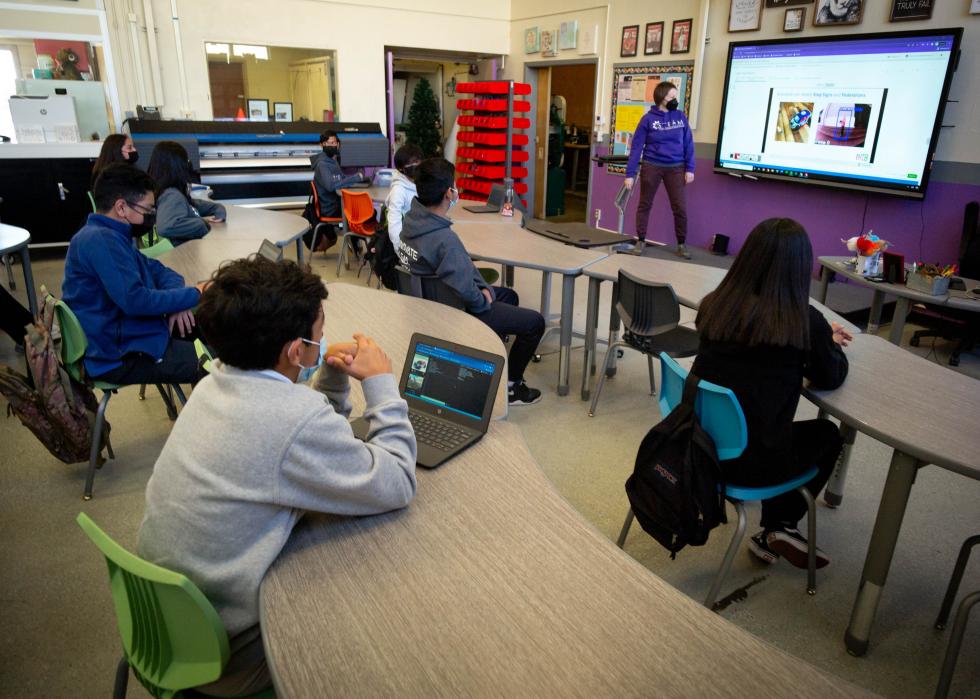
Types of teachers who are more likely to work 40+ hours a week
This story originally appeared on Study.com and was produced and distributed in partnership with Stacker Studio.
Types of teachers who are more likely to work 40+ hours a week
The average teacher is usually obligated to work 40 hours per week, but the reality is many educators work much longer hours to meet the academic and social needs of their students. In fact, teachers work 54 hours per week on average (only 25 of which is spent teaching).
Using survey data from O*NET, Study.com analyzed which types of teachers work over 40 hours a week most and least frequently. The data specifically looks at K-12 teachers and includes their annual median salary in 2021, total employment numbers, and projected job growth between 2020 and 2030, and for each teacher category. These secondary data points were pulled from the Bureau of Labor Statistics' employment projections.
School teachers typically juggle a busy workload that includes planning lessons, communicating with students and parents, filing paperwork and administrative forms, and many often spend evenings and weekends grading assignments—all on top of in-classroom teaching.
The pandemic pushed stress and workloads to new heights as many educators teach in-person and remotely at the same time and are expected to adapt quickly to a rapidly changing environment. Among K-12 educators, 52% expressed higher levels of stress and burnout, according to a 2021 report prepared by the MissionSquare Research Institute. A shortage of teachers, bus drivers, cafeteria workers, and substitute teachers have also increased workloads as fewer staff have to do more. In a January 2022 poll from The National Education Association (NEA), 55% of teachers plan to retire or leave the profession sooner than they intended due to the pandemic.
Despite these challenges, many educators still love teaching and said they were more likely to stay in the teaching compared to workers in other public sector fields, according to the NEA. Indeed, teaching can still be a rewarding career as educators help to simultaneously inspire and challenge young minds. Teachers can also be influential and motivating figures in a student's life.
The average expected job growth between 2020 and 2030 for K-12 teachers is about 7%–8% depending on the category, according to an analysis by the BLS. This rate is "as fast as the average" of other occupations, per the BLS.
While the percentages may vary for teachers who work more than 40 hours per week, the annual median salary hardly varies between teacher categories—the five included in this data set earn around $61,000 per year.

#7. High school career/technical education teachers
- Total employment: 72,300
- Portion who work more than 40 hours a week: 64%
- Median salary: $61,820
- Projected job openings 2020–2030: 5,100 (7.1% growth)
High school career/technical teachers prepare students for more technical careers, often teaching specific skill sets related to an industry or profession. Job duties may include observing students, grading classwork, and preparing materials for class instructions. Other job titles for this profession may include agricultural education teacher, allied health teacher, and vocational teacher.
As of May 2021, states with the highest employment rates for high school career/technical education teachers are Texas, Florida, New York, North Carolina, and Ohio.

#6. Middle school career/technical education teachers
- Total employment: 11,500
- Portion who work more than 40 hours a week: 65%
- Median salary: $61,820
- Projected job openings 2020–2030: 900 (7.8% growth)
Middle school teachers who specialize in technical education generally prepare and teach students for specific occupations. These educators help students to further develop their interests and promote critical thinking through hands-on learning experiences.
Middle school technical education teachers may work with web development software programs, such as Apache Tomcat and Google AngularJS.
As of May 2021, states with the highest employment opportunities for middle school teachers who specialize in technical/career education are Texas, New York, North Carolina, Virginia, and Washington.

#5. Kindergarten teachers
- Total employment: 121,300
- Portion who work more than 40 hours a week: 69%
- Median salary: $60,900
- Projected job openings 2020–2030: 9,800 (8.1% growth)
Kindergarten is a critical learning stage for students as it's generally the bridge from early education to elementary school. Kindergarten teachers have similar responsibilities as other elementary school teachers but may also have to consider many students will be experiencing school and learning in a classroom setting for the first time.
Kindergarten teachers prepare students for first grade and beyond by teaching basic skills, such as letter recognition, personal hygiene, and social interaction. These early-stage educators may also help students develop social skills like learning to behave nicely in a group setting or inspiring creativity through artwork.
As of May 2021, states with the highest employment opportunities for kindergarten teachers are Texas, California, Florida, New York, and New Jersey.

#4. High school teachers
- Total employment: 998,800
- Portion who work more than 40 hours a week: 70%
- Median salary: $61,820
- Projected job openings 2020–2030: 78,200 (7.8% growth)
High school teachers play a crucial role in students' lives during their formative years by encouraging conceptual and social development. Also referred to as secondary teachers, they generally teach students in the ninth through 12th grades.
High school teachers apply multiple teaching methods, assign and grade schoolwork, and evaluate students' behavior and progress. High school teachers may use computer training software such as Moodle and Schoology and other software programs such as PowerSchool SIS.
High school teachers usually have at least a bachelor's degree and are required to have a state-issued license, usually in the subject they are teaching.

#3. High school special education teachers
- Total employment: 140,900
- Portion who work more than 40 hours a week: 74%
- Median salary: $62,120
- Projected job openings 2020–2030: 10,800 (7.7% growth)
High school special education teachers develop and create programs for students with a range of disabilities. These educators may work with children who are on the autism spectrum, or who have learning challenges including emotional, visual, speech, or language differences.
Techniques used to foster learning include working in small groups and problem-solving, based on the student's needs. High school special education teachers in all U.S. states are required to be certified and licensed and complete training in special education.

#2. Elementary school teachers
- Total employment: 1.37 million
- Portion who work more than 40 hours a week: 79%
- Median salary: $61,400
- Projected job openings 2020–2030: 101,700 (7.4% growth)
Elementary school teachers generally teach students from kindergarten through fifth grade. These foundational years are usually a child's introduction to a structured learning environment. Educators, such as classroom teachers and art teachers, have a variety of tasks that keep them working more than 40 hours a week.
Besides creating lesson plans which oftentimes is outside work hours, classroom teachers have myriad responsibilities such as communicating with parents and guardians about the children's progress, participating in faculty meetings, and assisting children who are sick or hurt.

#1. Middle school teachers
- Total employment: 598,500
- Portion who work more than 40 hours a week: 81%
- Median salary: $61,320
- Projected job openings 2020–2030: 44,800 (7.5% growth)
Middle school teachers create and plan educational curricula in subject areas in the sixth to eighth grades while tracking student progress.
Middle school educators who often work more than 40 hours a week include English, language arts, math, and social studies teachers. The job duties include preparing teaching material by adapting to the student's developmental stage, grading assignments and tests, and enforcing behavioral rules and procedures.
For middle school teachers, lesson plans tend to be more structured, and educators may create more challenging lessons than in an elementary school where they focus on engagement and learning fundamentals.



